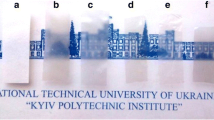Abstract
The main objective of this work was to extract microcrystalline cellulose (MCC) particles from different cellulosic resources like cotton, jute, newsprint, filter paper and investigate their suitability as green reinforcing material in biocomposites. The MCC particles were extracted by acid hydrolysis with 64% sulphuric acid. The processing parameters like acid concentration, temperature, time and mechanical force were kept constant. The MCC particles were studied by transmission electron microscopy (TEM), scanning electron microscopy (SEM), X-ray diffraction (XRD), particle size analysis, Fourier transform infrared spectroscopy and thermogravimetric analysis. The viscoelastic properties of the MCC particles were investigated with the help of nanoindentation technique for the first time. The acid hydrolysis changed the %crystallinity and crystallite sizes of the MCC particles compared to their source materials. The modulus and hardness of the MCC particles varied significantly depending on their precursors. The presence of non-cellulosic constituents controlled the deformation behaviour of the MCC particles. The thermal stability of the MCC particles was correlated with the tangling effect of the flexible cellulose chains.






Similar content being viewed by others
References
Tang LG, Hon David NS, Pan SH, Zhu YQ, Wang ZW, Zhen Z (1996) J Appl Polym Sci 59:483–488
Shlieout G, Arnold K, Muller G (2002) AAPS PharmScitech 3(2): 1–10 (article 11)
Lu Y, Weng L, Cao X (2006) Carbohydr Polym 63:198–204
Chakraborty A, Sain M, Holzforschung MK (2005) Cat Inst 59:102–107
Choi Y, Simonsen J (2006) J Nanosci Nanotechnol 6(3):633–639
Chakraborty A, Sain M, Kortschot M, Cutler S (2007) J Biobased Mater Bioenergy 1:71–77
Bhatnagar A, Sain M (2007) J Reinf Plast Compos 24:1259–1268
Angle`s MN, Dufresne A (2000) Macromolecules 33:8344–8353
Samir MASA, Alloin F, Paillet M, Dufresne A (2004) Macromolecules 37:4313–4316
Henriksson M, Berglund LA, Isaksson P, Lindstrom T, Nishino T (2008) Biomacromolecules 9:1579–1585
Zhao H, Kwak JH, Zhang ZC, Brown HM, Arey BW, Holladay JE (2007) Carbohydr Polym 68:235–241
Barun B, Dorgan JR (2009) Biomacromolecules 10:334–341
Habibi Y, Dufresne A (2008) Biomacromolecules 9:1974–1980
Mouro RC, Bouchet B, Pontoire B, Robert P, Mazoyer J, Buleon A (2003) Carbohydr Polym 53:241–252
Viet D, Candanedo BS, Gray GD (2007) Cellulose. doi:10.1007/s10570-006-9093-9
Bai W, Holbery J, Li K (2009) Cellulose. doi:10.1007/s10570-009-9277-1
Bondeson D, Mathew A, Oksman K (2006). doi:10.1007/s10570-006-9061-4
Ahola S, Salmi J, Johansson SL, Laine J, Osterberg M (2008) Biomacromolecules 9:1273–1282
Li Zhou, Renneckar S, Barone RJ (2009) Cellulose. doi:10.1007/s10570-009-9363-4
Seydibeyoglu OM, Oksman K (2008) Compos Sci Technol 68:908–914
Chen Y, Liu C, Chang RP, Cao X, Anderson PD (2009) Carbohydr Polym 76:607–615
Pandey JK, Lee JW, Chu WS, Kim CS, Lee CS, Ahn SH (2008) Macromol Res 16:396
Dong X, Kimura T, Revol J, Gray GD (1996) Langmuir 12:2076–2082
Klemm D, Philipp B, Heinz T, Heinz U, Wagenknecht W (2004) Comprehensive Cellulose Chemistry, vol 1. Fundamental and Analytical Methods, Wiley-VCH publication
Das K, Ray D, Bandyopadhyay NR, Ghosh T, Mohanty AK, Misra M (2009) Cellulose. doi:10.1007/s1070-009-9280-6
Revol JF, Dietrich A, Goring DAI (1987) Can J Chem 65:1724–1725
Wang S, Cheng Q, Rials GT, Lee HS (2007) Proceedings of the Pacific Rim bio-based composites symposium
Sinha E, Rout SK (2009) Bull Mater Sci 32:65–76
Schniewind AP (ed) (1989) Concise encyclopaedia of wood and wood based materials, 1st ed. Pergamon Press, Elmsford, pp 271–273. http://books.google.co.in/books?isbn=081382446X
Acknowledgements
Dipa Ray is thankful to AICTE (All India Council for Technical Education), Government of India, for granting her a project. Authors are grateful to Dr. P. C. Basu (Director, Petrology Division) and Ms. Kaberi Banerjee of Geological Survey of India, Kolkata, for their kind support in doing the particle size analysis. Dr. Sabyasachi Som and Mr. U. Kundu are gratefully acknowledged for their support in doing SEM analysis. Authors are also thankful to Mr. Shailendranath Dey of Indian Institute of Chemical Biology (IICB), Kolkata, India, for his help in doing the TEM analysis. Mr. Arijit Sinha (Research Scholar of BESU, Shibpur, Howrah) is also thankfully acknowledged for doing the Nanoindentation test.
Author information
Authors and Affiliations
Corresponding author
Rights and permissions
About this article
Cite this article
Das, K., Ray, D., Bandyopadhyay, N.R. et al. Study of the Properties of Microcrystalline Cellulose Particles from Different Renewable Resources by XRD, FTIR, Nanoindentation, TGA and SEM. J Polym Environ 18, 355–363 (2010). https://doi.org/10.1007/s10924-010-0167-2
Published:
Issue Date:
DOI: https://doi.org/10.1007/s10924-010-0167-2




